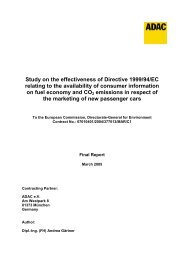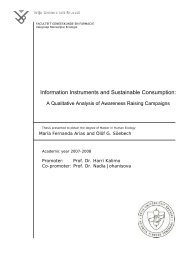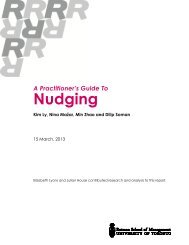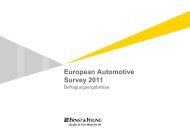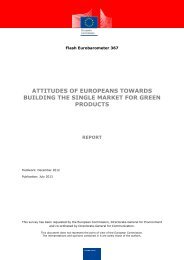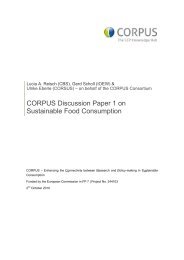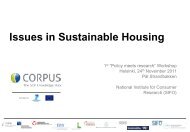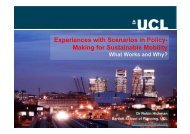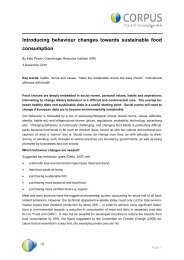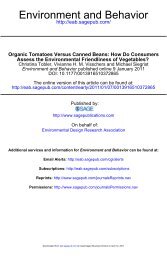Annual Report 2009 - Atmosfair
Annual Report 2009 - Atmosfair
Annual Report 2009 - Atmosfair
Create successful ePaper yourself
Turn your PDF publications into a flip-book with our unique Google optimized e-Paper software.
The limits of carbon offset<br />
Product compensation<br />
What do cut flowers, laptops, peat, hot dogs, life, and<br />
driving a car all have in common? You can buy them<br />
as “climate neutral” products or you can make them<br />
“climate neutral.” The additional charge is low and all<br />
CO 2<br />
emissions are offset, that’s how simple the world<br />
is. At least it’s easy to think so if you follow this issue<br />
on the news or read related advertisements. The consumer<br />
center Verbraucherzentrale Hessen determined<br />
in <strong>2009</strong> that the terms “climate neutral” and “carbon<br />
neutral” are confusing and sometimes even deceitful.<br />
(Press release: Produktinformation zwischen Wahrheit<br />
und Täuschung: wer sind die größten Grünfärber?—<br />
Product information between truth and trickery: Who<br />
are the leading greenwashers?).<br />
atmosfair goes one step further and asks whether socalled<br />
product neutrality might not harm the climate<br />
more than it helps. Those selling the products regularly<br />
claim that greenhouse gas reductions during production<br />
have priority over offset and that only the remaining,<br />
unavoidable emissions are offset. But in practice,<br />
this is quickly revealed as mere lip service (see box).<br />
CO 2<br />
offset schemes thus quickly enter into competition<br />
with real solutions—already in existence—that make<br />
it possible to create truly climate-friendly products. For<br />
example electricity, now sold in Germany by certified<br />
green electricity providers. These providers invest their<br />
surplus charges in building new capacities (wind turbines,<br />
etc.) to meet consumers’ electricity demands.<br />
Only in this way does money for climate protection go<br />
towards indispensible technological innovation; only<br />
in this way will the costs of green technologies drop.<br />
If instead money goes towards offset projects in developing<br />
countries, greenhouse gas emissions are reduced,<br />
but there is no driving force for innovation. Studies<br />
have shown that this is not the path towards true<br />
climate protection. That’s why the EU has put restrictions<br />
on the purchase of CO 2<br />
certificates from developing<br />
countries.<br />
Do CO 2<br />
neutral products make sense at all? That depends<br />
on the product! It’s worthwhile taking a closer<br />
look—atmosfair began a study on this question in<br />
<strong>2009</strong>.<br />
Examples of questionable “climate-neutral” products<br />
climate-neutral electricity (offsetted)<br />
• Products: Electricity in private households, for conferences, printed materials, server hosting or as a flat surcharge<br />
on the purchase of a laptop, accommodations, etc.<br />
• Questionable: Old coal-fired power plants remain in operation, real climate solutions are blocked (I’m already<br />
buying “climate-neutral”).<br />
• True climate solution: electricity from renewable energy sources<br />
Climate-neutral driving<br />
• Climate-neutral products: Climate-neutral labels for a fixed amount of kilometers, fuel, leasing, etc.<br />
• Questionable: Competes with true climate solutions; indirect incentive to continue driving (I’m already driving<br />
“climate-neutral”)<br />
• True climate solution: Take the train, car pool, car share, drive slower, buy a smaller car. Incentives are weakened<br />
by offset.<br />
Climate-neutral meat<br />
• Climate-neutral products: meat in supermarkets, organic food stores, restaurants, etc.<br />
• Questionable: To protect the climate, the global consumption of meat must be drastically reduced, there is no<br />
technical alternative. Offset only prolongs a dead-end situation.<br />
• True climate solution: Eat less meat, eat meat from local farmers, dietary changes<br />
Counterexample: Long-distance flight with atmosfair<br />
• True climate solution: fly slower, take a boat, car pool, book a fuel-efficient airplane, etc.: These options are usually<br />
not available. In reality, you can only abstain from flying. Whoever does not wish to do so, or cannot do so, can<br />
at least offset emissions with atmosfair and bridge the time gap until clean technologies are developed<br />
25



